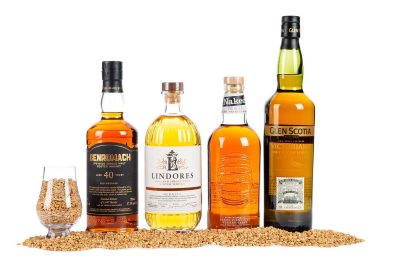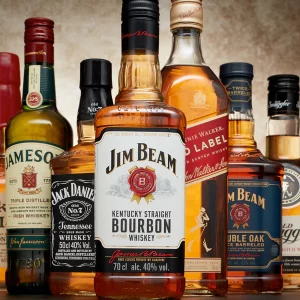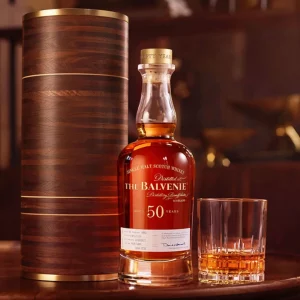Scotch is a type of whiskey that is produced in Scotland. Whiskey, also spelled whisky, is a distilled alcoholic beverage made from fermented grain mash. The term “whiskey” is derived from the Gaelic term “uisge beatha,” which means “water of life.”
Whiskey is produced all over the world, including in the United States, Ireland, Canada, and Japan, among other countries. However, when it comes to Scotch, there is a question that often arises: is Scotch considered whiskey? The answer is yes; Scotch is indeed a type of whiskey.
What is Scotch Whiskey?
Scotch whiskey, also known as Scotch or Scottish whiskey, is a type of whiskey that is made in Scotland. It is a popular and well-known type of whiskey that is enjoyed by many people around the world.
To be classified as Scotch whiskey, the spirit must be made from malted barley, water, and yeast. It must also be aged in oak casks for at least three years. The production and aging of Scotch whiskey are regulated by Scottish law, which ensures that the final product meets certain quality standards.
Scotch whiskey is known for its distinctive flavor, which can vary depending on the specific type of Scotch and the aging process it goes through. Some common types of Scotch whiskey include single malt Scotch, blended Scotch, and peated Scotch. Each of these types has its own unique flavor profile and characteristics.
Overall, Scotch whiskey is a beloved and respected type of whiskey that has a rich history and culture surrounding it. From the rolling hills of Scotland to the bars and homes of whiskey enthusiasts around the world, Scotch whiskey has earned its place as a beloved and iconic spirit.
Is scotch considered whiskey?
Yes, Scotch is considered a type of whiskey. Specifically, it is a type of whiskey that is produced in Scotland and is subject to the regulations set forth by the Scotch Whisky Regulations. These regulations require that Scotch whiskey be made from certain ingredients, such as malted barley, and be aged for a minimum of three years in oak casks.
The end product is a spirit that is widely recognized for its unique flavor profile and is enjoyed by whiskey enthusiasts around the world.
The Distillation Process of Scotch Whiskey
The distillation process of Scotch whiskey is a complex and carefully controlled process that is crucial to creating the unique flavor and character of the final product.
Here are the main steps involved in the distillation process of Scotch whiskey:
- Malting: The first step in making Scotch whiskey is malting, which involves soaking barley in water and allowing it to germinate. This process activates enzymes in the barley that convert starches into sugars.
- Mashing: After the barley has been malted, it is ground up and mixed with hot water to create a mash. The mash is then cooled, and yeast is added, which starts the fermentation process.
- Fermentation: The mash is then left to ferment for several days, during which time the yeast converts the sugars in the mash into alcohol.
- Distillation: After fermentation is complete, the liquid is transferred to stills, which are large copper vessels used for distillation. The liquid is heated, and the alcohol vaporizes and rises to the top of the still, where it is collected.
- Double distillation: Scotch whiskey is typically double-distilled, which means the liquid is distilled twice. This helps to purify the alcohol and create a smoother, more refined spirit.
- Maturation: After distillation, the spirit is aged in oak casks for a minimum of three years. During this time, the whiskey takes on the flavors of the wood, as well as the surrounding environment, which can affect the final flavor profile.
The distillation process of Scotch whiskey is a time-consuming and meticulous process that requires careful attention to detail and a deep understanding of the science behind the process. But the end result is a unique and beloved spirit that is enjoyed by whiskey enthusiasts around the world.
Origins of Scotch Whiskey
Scotch whiskey, also known as Scotch, is a type of whiskey that originates from Scotland. Its history dates back to the 15th century, where the first written record of whiskey production in Scotland can be found in the Exchequer Rolls of 1494, where malt was purchased for the production of whiskey for King James IV of Scotland.
The production of Scotch whiskey grew in popularity over the centuries, with the introduction of the column still in the 1820s leading to increased production and a more consistent product. In 1860, the Phylloxera epidemic devastated the French wine industry, leading to a surge in demand for Scotch whiskey in Europe.
Today, Scotch whiskey is protected as a product of origin under UK law, meaning that it can only be produced in Scotland, using specific methods and ingredients. There are five main regions of Scotch whiskey production, each with its own unique characteristics: the Highlands, Lowlands, Speyside, Islay, and Campbeltown.
Scotch whiskey has become a staple of Scottish culture and is enjoyed all over the world. Its rich history and unique flavors continue to make it a beloved drink for whiskey enthusiasts and casual drinkers alike.
How Scotch Whiskey is Aged
Scotch whiskey is typically aged in oak barrels, which gives the whiskey its characteristic color, flavor, and aroma. The aging process can take several years, with the minimum legal requirement being three years, although many Scotch whiskeys are aged for much longer.
During the aging process, the whiskey interacts with the wood of the barrel, which can impart flavors such as vanilla, caramel, and oak. The whiskey also takes on the color of the barrel, becoming darker over time. The temperature and humidity of the aging environment can also impact the flavor and aroma of the whiskey.
Scotch whiskey must be aged in Scotland, and the type of barrel used is regulated by law. The most common type of barrel used is the ex-bourbon barrel, which has previously been used to age bourbon in the United States. Other types of barrels, such as sherry or port barrels, can also be used for additional flavor and complexity.
Once the aging process is complete, the whiskey is typically blended with other whiskeys of different ages to achieve a consistent flavor profile. Some single malt Scotch whiskeys, however, is not blended and are instead bottled from a single cask.
The aging process is an important aspect of Scotch whiskey production, and the length of time and type of barrel used can greatly impact the final product. The result is a complex and nuanced spirit that is enjoyed by whiskey enthusiasts around the world.
The Role of Barrels in Scotch Whiskey Aging
Barrels play a crucial role in the aging process of Scotch whiskey. The type of barrel used and the length of time that the whiskey spends in the barrel can greatly impact the final flavor, aroma, and color of the whiskey.
The most common type of barrel used for aging Scotch whiskey is the ex-bourbon barrel. These barrels are made of American white oak and have previously been used to age bourbon in the United States. The barrels are shipped to Scotland, where they are filled with new-made spirits and left to age. The oak in the barrel imparts flavors of vanilla, caramel, and oak while also giving the whiskey its characteristic color.
Other types of barrels, such as sherry or port barrels, can also be used for aging Scotch whiskey. These barrels can impart different flavors, such as dried fruit or spice, to the whiskey. The use of different barrels can create a complex and nuanced flavor profile in the final product.
The length of time that the whiskey spends in the barrel can also greatly impact its flavor. The minimum legal requirement for aging Scotch whiskey is three years, although many Scotch whiskeys are aged for much longer. The longer the whiskey spends in the barrel, the more it interacts with the wood and takes on its flavors.
Overall, the use of barrels in Scotch whiskey aging is an important aspect of the production process. The type of barrel used and the length of time that the whiskey spends in the barrel can greatly impact the final flavor, aroma, and color of the whiskey, resulting in a complex and nuanced spirit that is enjoyed by whiskey enthusiasts around the world.
The Different Types of Scotch Whiskey
There are several different types of Scotch whiskey, each with its own unique characteristics:
- Single malt Scotch whiskey: This type of whiskey is made entirely from malted barley and water, distilled in pot stills at a single distillery. Single malt Scotch whiskey is known for its complex flavors and aromas and is often aged for many years in oak barrels.
- Blended Scotch whiskey: This type of whiskey is a blend of different malt and grain whiskeys from multiple distilleries. Blended Scotch whiskeys are typically more affordable than single malt whiskeys and have a consistent flavor profile.
- Blended malt Scotch whiskey: This type of whiskey is a blend of different single-malt Scotch whiskeys from multiple distilleries. Blended malt Scotch whiskeys offer a wide range of flavors and are often more complex than blended Scotch whiskeys.
- Single-grain Scotch whiskey: This type of whiskey is made from malted barley and other grains, such as wheat or corn, and is distilled in column stills at a single distillery. Single-grain Scotch whiskeys are often used in blends but can also be enjoyed on their own.
- Cask strength Scotch whiskey: This type of whiskey is bottled directly from the cask without any dilution, resulting in a higher alcohol content and a more intense flavor.
- Peated Scotch whiskey: This type of whiskey is made using malted barley that has been dried over peat fires, giving it a distinct smoky flavor. Peated Scotch whiskeys are often produced on the island of Islay and are known for their strong and complex flavors.
Each type of Scotch whiskey offers a unique flavor profile and aroma, making it easy to find a whiskey that suits your taste preferences.
The Importance of Location in Scotch Whiskey Production
Location plays a significant role in Scotch whiskey production. By law, Scotch whiskey must be distilled and aged in Scotland, and the country’s unique geography and climate contribute to the distinctive character of the spirit.
One of the most important factors is Scotland’s abundance of fresh, clean water. This water is essential for the production of Scotch whiskey, as it is used in every step of the process, from mashing the barley to reducing the alcohol content before bottling. Scotland’s natural water sources, such as the rivers and springs in the Highlands and Lowlands, contribute to the flavor profile of the whiskey.
Scotland’s climate is also important in Scotch whiskey production. The cool, damp climate provides the perfect conditions for aging whiskey, as it slows down the evaporation process and allows the whiskey to absorb flavors from the oak barrels. The temperature and humidity levels in different parts of Scotland can also impact the flavor and aroma of the whiskey, leading to regional differences in Scotch whiskey production.
How to Properly Serve and Drink Scotch Whiskey
Scotch whiskey is a complex and nuanced spirit that should be enjoyed and savored properly. Here are some tips on how to properly serve and drink Scotch whiskey:
- Choose the right glass: The preferred glass for serving Scotch whiskey is a tulip-shaped glass, also known as a Glencairn glass. This type of glass allows you to swirl and appreciate the aromas of the whiskey while also directing them toward your nose.
- Add a small amount of water: Many Scotch whiskey enthusiasts prefer to add a small amount of water to their whiskey, as it can open up the flavors and aromas. Start with a small amount and add more if desired.
- Hold the glass properly: When holding the glass, grip it by the stem or the base to avoid warming the whiskey with your hands. This will help to maintain the whiskey’s temperature and prevent the flavors from becoming too muted.
- Take small sips: Rather than taking large gulps, take small sips of the whiskey to fully appreciate the flavors and aromas. Swirl the whiskey in your mouth to taste it fully, and take note of any subtle nuances in the flavor profile.
- Pair with complementary flavors: Scotch whiskey can be enjoyed on its own, but it can also be paired with complementary flavors such as dark chocolate, nuts, or cheese. The right pairing can enhance the flavors of the whiskey and provide a more enjoyable drinking experience.
Overall, drinking Scotch whiskey is a sensory experience that should be approached with care and appreciation. By following these tips, you can fully savor the complex flavors and aromas of this beloved spirit.
How Scotch Whiskey is Graded and Classified
Scotch whiskey is graded and classified based on a variety of factors, including its age, distillery, and production methods. Here are some of the most common grading and classification systems used for Scotch whiskey:
- Age: Scotch whiskey is often graded based on its age, which is typically listed on the bottle. Common age statements include 12 years, 18 years, and 25 years. The older the whiskey, the more expensive it tends to be, as longer aging can result in more complex and nuanced flavors.
- Region: Scotch whiskey is often classified based on the region in which it was produced. The five main Scotch whiskey regions are the Highlands, Lowlands, Speyside, Islay, and Campbeltown. Each region has its own unique flavor profile, influenced by factors such as the local climate, water sources, and production methods.
- Distillery: Some Scotch whiskeys are classified based on the distillery where they were produced. This can be helpful for enthusiasts who are familiar with the unique characteristics of different distilleries.
- Production method: Scotch whiskey can also be classified based on its production method, such as whether it was made using peat-smoked barley or matured in sherry casks. These factors can greatly influence the flavor profile of the whiskey.
- Quality: Finally, Scotch whiskey can be graded based on its overall quality, as determined by experts in the industry. For example, the Scotch Whisky Association has a panel of tasters who grade whiskeys based on their quality and adherence to industry standards.
By understanding these grading and classification systems, whiskey enthusiasts can better appreciate the nuances and complexities of Scotch whiskey.
Popular Brands of Scotch Whiskey
There are many popular brands of Scotch whiskey, each with its own unique flavor profiles and characteristics.
Here are some of the most well-known brands:
- Johnnie Walker: One of the most famous Scotch whiskey brands in the world, Johnnie Walker offers a range of blends to suit every taste and budget, from the entry-level Red Label to the premium Blue Label.
- Glenlivet: Known for its smooth and fruity flavors, Glenlivet is one of the best-selling single malt Scotch whiskeys in the world. The brand offers a range of ages and finishes, including 12-year and 18-year expressions.
- Macallan: Macallan is renowned for its rich and complex flavors, which come from aging its whiskeys in sherry casks. The brand offers a range of ages and finishes, including the highly sought-after 25-year and 30-year expressions.
- Talisker: Hailing from the Isle of Skye, Talisker is known for its smoky and peaty flavors, which come from using peat-smoked barley in the production process. The brand offers a range of ages and finishes, including the popular 10-year expression.
- Laphroaig: Another peaty Scotch whiskey, Laphroaig is known for its bold and intense flavors, which can be an acquired taste for some. The brand offers a range of ages and finishes, including the 10-year and the heavily peated 10-year Cask Strength expression.
These are just a few examples of the many popular brands of Scotch whiskey available on the market today. Each brand offers its own unique flavors and characteristics, making it easy for whiskey enthusiasts to find a favorite that suits their taste preferences.
Comparing Scotch Whiskey to Other Types of Whiskey
Scotch whiskey is a type of whiskey that is distilled in Scotland, whereas other types of whiskey, such as bourbon, rye, and Irish whiskey, are produced in different regions and countries.
One of the most significant differences between Scotch whiskey and other types of whiskey is the production process. Scotch whiskey is distilled twice and aged for a minimum of three years in oak barrels, while bourbon is distilled only once and aged in charred oak barrels. Rye whiskey, on the other hand, is made from a mash bill of at least 51% rye, while Irish whiskey is usually triple-distilled and aged for at least three years.
Another difference is the flavor profile. Scotch whiskey is known for its smoky, peaty flavor, which comes from the use of peat in the malting process. Bourbon, on the other hand, has a sweeter taste due to the higher percentage of corn in the mash bill. Rye whiskey is characterized by its spiciness, while Irish whiskey tends to be smoother and more delicate.
Overall, the different types of whiskey offer a range of flavors and characteristics, making them distinct from each other. It ultimately comes down to personal preference and taste when choosing which type of whiskey to enjoy.
Conclusion
This page on is scotch considered whiskey covers all that you need to know about scotch drink. Scotch whiskey is a unique type of whiskey that is produced in Scotland through a distinct process that involves double distillation and aging in oak barrels for at least three years.
It is known for its smoky, peaty flavor and is one of the most popular types of whiskey in the world. While it differs from other types of whiskey in terms of the production process and flavor profile, it ultimately comes down to individual preference when choosing which type of whiskey to enjoy.




